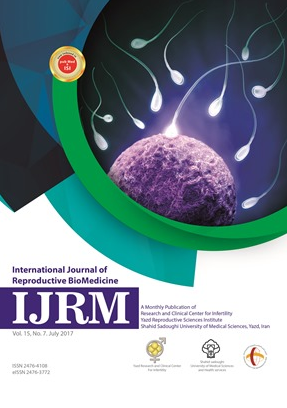
International Journal of Reproductive BioMedicine
ISSN: 2476-3772
The latest discoveries in all areas of reproduction and reproductive technology.
Drug-free in vitro activation and autologous transplantation in infertile women with diminished ovarian reserve: An experimental pilot study
Published date: Jul 31 2024
Journal Title: International Journal of Reproductive BioMedicine
Issue title: International Journal of Reproductive BioMedicine (IJRM): Volume 22, Issue No. 6
Pages: 425 - 432
Authors:
Abstract:
Background: Poor ovarian response and diminished ovarian reserves (DOR) significantly contribute to female infertility. Previous attempts have been made to enhance follicular growth and improve pregnancy outcomes in these participants.
Objective: This study aimed to assess the efficacy of the in vitro drug-free activation technique of the ovarian reservation and in vitro fertilization stimulation cycle outcomes in DOR participants.
Materials and Methods: This pilot phase study investigated the impact of in vitro activation (IVA) on ovarian reservation and in vitro fertilization outcome in 10 infertile women with DOR from May to December 2023 at Taleghani Infertility Center, Tehran, Iran. Participants underwent general surgery and laparoscopy, involving the removal of a portion of one ovary, immediate transfer to the laboratory, dissection into small cubes, and subsequent re-implantation into the cases’s ovary. The primary outcomes, include the count of retrieved oocytes, the number of oocytes reaching metaphase, and the secondary outcomes were the quantity and the number of embryos transferred, implantation rate, and occurrence of clinical pregnancy.
Results: The study revealed a significant increase in the antral follicle count before and after IVA (p = 0.033). Before IVA, the median estradiol level was 93.5 (57.0), which reduced to 79.0 (35.0) after IVA, indicating a statistically significant difference. On average, 2.3 (0.8) oocytes were retrieved, among which 1.5 (0.7) were metaphase II oocytes. The observed pregnancy rate among the 2 cases was 22.2%.
Conclusion: The current study suggests that IVA may positively impact follicular growth and pregnancy outcomes among women with DOR.
Key words: In vitro fertilization, Autologous transplantation, Infertility, Ovarian reserve.
References:
[1] Vo KCT, Kawamura K. In vitro activation early follicles: From the basic science to the clinical perspectives. Int J Mol Sci 2021; 22: 3785.
[2] Ferreri J, Fàbregues F, Calafell JM, Solernou R, Borrás A, Saco A, et al. Drug-free in-vitro activation of follicles and fresh tissue autotransplantation as a therapeutic option in patients with primary ovarian insufficiency. Reprod Biomed Online 2020; 40: 254–260.
[3] Wang W, Todorov P, Isachenko E, Rahimi G, Mallmann P, Wang M, et al. In vitro activation of cryopreserved ovarian tissue: A single-arm meta-analysis and systematic review. Eur J Obstet Gynecol Reprod Biol 2021; 258: 258–264.
[4] Devenutto L, Quintana R, Quintana T. In vitro activation of ovarian cortex and autologous transplantation: A novel approach to primary ovarian insufficiency and diminished ovarian reserve. Hum Reprod Open 2020; 2020: hoaa046.
[5] Roque M, Haahr T, Esteves SC, Humaidan P. The POSEIDON stratification - moving from poor ovarian response to low prognosis. JBRA Assist Reprod 2021; 25: 282–292.
[6] Fabregues F, Ferreri J, Calafell JM, Moreno V, Borrás A, Manau D, et al. Pregnancy after drug-free in vitro activation of follicles and fresh tissue autotransplantation in primary ovarian insufficiency patient: A case report and literature review. J Ovarian Res 2018; 11: 76.
[7] Nelson LM. Clinical practice: Primary ovarian insufficiency. N Engl J Med 2009; 360: 606–614.
[8] Alpha Scientists in Reproductive Medicine and ESHRE Special Interest Group of Embryology. The Istanbul consensus workshop on embryo assessment: Proceedings of an expert meeting. Hum Reprod 2011; 26: 1270–1283.
[9] Kawamura K, Ishizuka B, Hsueh AJW. Drug-free in-vitro activation of follicles for infertility treatment in poor ovarian response patients with decreased ovarian reserve. Reprod Biomed Online 2020; 40: 245–253.
[10] Hsueh AJW, Kawamura K, Cheng Y, Fauser BCJM. Intraovarian control of early folliculogenesis. Endocr Rev 2015; 36: 1–24.
[11] Li L, Sun B, Wang F, Zhang Y, Sun Y. Which factors are associated with reproductive outcomes of DOR patients in ART cycles: An eight-year retrospective study. Front Endocrinol (Lausanne) 2022; 13: 796199.
[12] Huang Y, Li J, Zhang F, Liu Y, Xu G, Guo J, et al. Factors affecting the live-birth rate in women with diminished ovarian reserve undergoing IVF-ET. Arch Gynecol Obstet 2018; 298: 1017–1027.